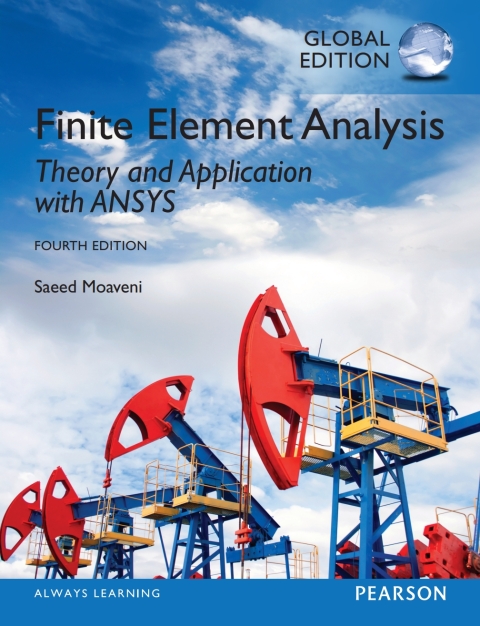Description
Efnisyfirlit
- Title
- Copyright
- Contents
- Preface
- Acknowledgments
- 1 Introduction
- 1.1 Engineering Problems
- 1.2 Numerical Methods
- 1.3 A Brief History of the Finite Element Method and Ansys
- 1.4 Basic Steps in the Finite Element Method
- 1.5 Direct Formulation
- 1.6 Minimum Total Potential Energy Formulation
- 1.7 Weighted Residual Formulations
- 1.8 Verification of Results
- 1.9 Understanding the Problem
- Summary
- References
- Problems
- 2 Matrix Algebra
- 2.1 Basic Definitions
- 2.2 Matrix Addition or Subtraction
- 2.3 Matrix Multiplication
- 2.4 Partitioning of a Matrix
- 2.5 Transpose of a Matrix
- 2.6 Determinant of a Matrix
- 2.7 Solutions of Simultaneous Linear Equations
- 2.8 Inverse of a Matrix
- 2.9 Eigenvalues and Eigenvectors
- 2.10 Using Matlab to Manipulate Matrices
- 2.11 Using Excel to Manipulate Matrices
- Summary
- References
- Problems
- 3 Trusses
- 3.1 Definition of a Truss
- 3.2 Finite Element Formulation
- 3.3 Space Trusses
- 3.4 Overview of the Ansys Program
- 3.5 Examples Using Ansys
- 3.6 Verification of Results
- Summary
- References
- Problems
- 4 Axial Members, Beams, and Frames
- 4.1 Members Under Axial Loading
- 4.2 Beams
- 4.3 Finite Element Formulation of Beams
- 4.4 Finite Element Formulation of Frames
- 4.5 Three-Dimensional Beam Element
- 4.6 An Example Using Ansys
- 4.7 Verification of Results
- Summary
- References
- Problems
- 5 One-Dimensional Elements
- 5.1 Linear Elements
- 5.2 Quadratic Elements
- 5.3 Cubic Elements
- 5.4 Global, Local, and Natural Coordinates
- 5.5 Isoparametric Elements
- 5.6 Numerical Integration: Gauss–Legendre Quadrature
- 5.7 Examples of One-Dimensional Elements in Ansys
- Summary
- References
- Problems
- 6 Analysis of One-Dimensional Problems
- 6.1 Heat Transfer Problems
- 6.2 A Fluid Mechanics Problem
- 6.3 An Example Using Ansys
- 6.4 Verification of Results
- Summary
- References
- Problems
- 7 Two-Dimensional Elements
- 7.1 Rectangular Elements
- 7.2 Quadratic Quadrilateral Elements
- 7.3 Linear Triangular Elements
- 7.4 Quadratic Triangular Elements
- 7.5 Axisymmetric Elements
- 7.6 Isoparametric Elements
- 7.7 Two-Dimensional Integrals: Gauss–Legendre Quadrature
- 7.8 Examples of Two-Dimensional Elements in Ansys
- Summary
- References
- Problems
- 8 More Ansys
- 8.1 Ansys Program
- 8.2 Ansys Database and Files
- 8.3 Creating a Finite Element Model with Ansys: Preprocessing
- 8.4 h-Method Versus p-Method
- 8.5 Applying Boundary Conditions, Loads, and the Solution
- 8.6 Results of Your Finite Element Model: Postprocessing
- 8.7 Selection Options
- 8.8 Graphics Capabilities
- 8.9 Error-Estimation Procedures
- 8.10 An Example Problem
- Summary
- References
- 9 Analysis of Two-Dimensional Heat Transfer Problems
- 9.1 General Conduction Problems
- 9.2 Formulation with Rectangular Elements
- 9.3 Formulation with Triangular Elements
- 9.4 Axisymmetric Formulation of Three-Dimensional Problems
- 9.5 Unsteady Heat Transfer
- 9.6 Conduction Elements Used by Ansys
- 9.7 Examples Using Ansys
- 9.8 Verification of Results
- Summary
- References
- Problems
- 10 Analysis of Two-Dimensional Solid Mechanics Problems
- 10.1 Torsion of Members with Arbitrary Cross-Section Shape
- 10.2 Plane-Stress Formulation
- 10.3 Isoparametric Formulation: Using a Quadrilateral Element
- 10.4 Axisymmetric Formulation
- 10.5 Basic Failure Theories
- 10.6 Examples Using Ansys
- 10.7 Verification of Results
- Summary
- References
- Problems
- 11 Dynamic Problems
- 11.1 Review of Dynamics
- 11.2 Review of Vibration of Mechanical and Structural Systems
- 11.3 Lagrange’s Equations
- 11.4 Finite Element Formulation of Axial Members
- 11.5 Finite Element Formulation of Beams and Frames
- 11.6 Examples Using Ansys
- Summary
- References
- Problems
- 12 Analysis of Fluid Mechanics Problems
- 12.1 Direct Formulation of Flow Through Pipes
- 12.2 Ideal Fluid Flow
- 12.3 Groundwater Flow
- 12.4 Examples Using Ansys
- 12.5 Verification of Results
- Summary
- References
- Problems
- 13 Three-Dimensional Elements
- 13.1 The Four-NodeTetrahedral Element
- 13.2 Analysis of Three-Dimensional Solid Problems Using Four-NodeTetrahedral Elements
- 13.3 The Eight-Node Brick Element
- 13.4 The Ten-Node Tetrahedral Element
- 13.5 The Twenty-Node Brick Element
- 13.6 Examples of Three-Dimensional Elements in Ansys
- 13.7 Basic Solid-Modeling Ideas
- 13.8 A Thermal Example Using Ansys
- 13.9 A Structural Example Using Ansys
- Summary
- References
- Problems
- 14 Design and Material Selection
- 14.1 Engineering Design Process
- 14.2 Material Selection
- 14.3 Electrical, Mechanical, and Thermophysical Properties of Materials
- 14.4 Common Solid Engineering Materials
- 14.5 Some Common Fluid Materials
- Summary
- References
- Problems
- 15 Design Optimization
- 15.1 Introduction to Design Optimization
- 15.2 The Parametric Design Language of Ansys
- 15.3 Examples of Batch Files
- Summary
- References
- Problems
- Appendix A Mechanical Properties of Some Materials
- Appendix B Thermophysical Properties of Some Materials
- Appendix C Properties of Common Line and Area Shapes
- Appendix D Geometrical Properties of Structural Steel Shapes
- Appendix E Conversion Factors
- Appendix F An Introduction to MATLAB
- Index
- A
- B
- C
- D
- E
- F
- G
- H
- I
- J
- K
- L
- M
- N
- O
- P
- Q
- R
- S
- T
- U
- V
- W
- Y






Reviews
There are no reviews yet.